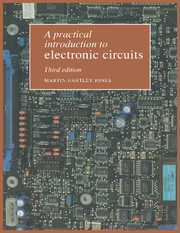Book contents
- Frontmatter
- Contents
- Preface to the third edition
- Preface to the second edition
- Preface to the first edition
- 1 Amplification and the transistor
- 2 The field-effect transistor
- 3 Thermionic valves and the cathode-ray tube
- 4 Negative feedback
- 5 Impedance matching
- 6 Semiconductor device characteristics
- 7 Amplification at high frequencies
- 8 Low-frequency signals, d.c. and the differential amplifier
- 9 Power supplies and power control
- 10 Pulse handling and time constants
- 11 Integrated circuit analogue building bricks
- 12 Positive feedback circuits and signal generators
- 13 Digital logic circuits
- 14 Microcomputer circuits and applications
- Appendix 1 Component identification
- Appendix 2 Transistor selection
- Appendix 3 Op amp data
- Appendix 4 Digital IC connections
- Appendix 5 Interfacing to the PC
- Bibliography
- Index
8 - Low-frequency signals, d.c. and the differential amplifier
Published online by Cambridge University Press: 05 June 2012
- Frontmatter
- Contents
- Preface to the third edition
- Preface to the second edition
- Preface to the first edition
- 1 Amplification and the transistor
- 2 The field-effect transistor
- 3 Thermionic valves and the cathode-ray tube
- 4 Negative feedback
- 5 Impedance matching
- 6 Semiconductor device characteristics
- 7 Amplification at high frequencies
- 8 Low-frequency signals, d.c. and the differential amplifier
- 9 Power supplies and power control
- 10 Pulse handling and time constants
- 11 Integrated circuit analogue building bricks
- 12 Positive feedback circuits and signal generators
- 13 Digital logic circuits
- 14 Microcomputer circuits and applications
- Appendix 1 Component identification
- Appendix 2 Transistor selection
- Appendix 3 Op amp data
- Appendix 4 Digital IC connections
- Appendix 5 Interfacing to the PC
- Bibliography
- Index
Summary
Introduction
So far in our discussion of amplifiers, a vital component in the design has been the coupling capacitor which transmits the a.c. signals but removes the steady d.c. voltage present at the input and output of each stage. This is necessary in order to avoid one stage upsetting the operation of adjacent ones.
A two-stage capacitor-coupled amplifier is shown in fig. 8.1 together with quiescent d.c. voltages. It is clear that C2 is isolating the collector of T1 (which needs to sit at 4.5 V for correct operation) from the base of T2, which is only 0.6 V above the grounded emitter, being a forward-biased junction. Making a direct connection between stages, omitting C2, would have the unfortunate result of clamping the collector of T1 only about 0.6 V above 0 V and passing a 2 mA base current into T2 through T1 collector load, permanently bottoming T2. The design would not be a success!
Coupling capacitors can, however, be eliminated by special d.c. amplifier design which is employed in virtually all present-day circuitry. There are two main reasons for this. The first, very practical, reason is that large capacitors cannot be fabricated on ICs, the maximum being a few tens of picofarads. The second reason is that the coupling capacitor inevitably leads to attenuation and phase shift at low frequencies: after all, there is no clear distinction between low-frequency a.c. and slowly changing d.c. and it is impossible to provide isolation from the latter without affecting the former.
- Type
- Chapter
- Information
- A Practical Introduction to Electronic Circuits , pp. 174 - 199Publisher: Cambridge University PressPrint publication year: 1995



